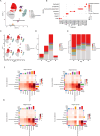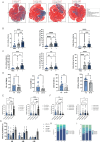Role of T cell exhaustion and tissue-resident memory T cells in the expression and prognosis of colorectal cancer
- PMID: 40764738
- PMCID: PMC12325763
- DOI: 10.1038/s41598-025-14409-x
Role of T cell exhaustion and tissue-resident memory T cells in the expression and prognosis of colorectal cancer
Abstract
The tumour microenvironment (TME) is complex and dynamic, and changes significantly with tumour progression. Studying the evolving state of T cells, especially tumour-specific subsets, has become feasible. However, the roles of exhausted T cells (Tex) and pre-exhausted tissue-resident memory T cells (pf-Trm), which emerge after prolonged antigen stimulation, remain unclear. Using single-cell sequencing data, we analyzed the immune landscape of patients with colorectal cancer (CRC) across clinical stages to quantify the abundance of T cell subtypes. Functional enrichment analysis revealed that early stage Tex cells retained some functionality, whereas advanced stage Tex cells showed a significant functional loss. Early stage pf-Trm cells actively participate in immune surveillance and antigen presentation, whereas advanced stage pf-Trm cells exhibit reduced functions. Flow cytometry analysis of clinical cohorts was used to measure the proportions of Tex and pf-Trm. Elevated levels of PD-1 and Tim-3 have been detected in TILs from CRC patients. Data from The Cancer Genome Atlas (TCGA) linked high Tex levels to poor prognosis in CRC, while pf-Trm correlated with better outcomes in early CRC but worse outcomes in advanced CRC due to functional exhaustion. Thus, Tex and pf-Trm cells may serve as prognostic biomarkers, and Tim-3 and CD103 may be promising targets for immune checkpoint inhibitors.
Keywords: Clinical prognosis; Colorectal cancer; Pre-failure tissue-resident memory T cells; T-cell exhaustion; Tumour microenvironment.
© 2025. The Author(s).
Conflict of interest statement
Declarations. Competing interests: The authors declare no competing interests. Ethical approval: Approval of the research protocol by an Institutional Reviewer Board. Informed consent: Informed consents were provided by all the participants.
Figures






Similar articles
-
Colorectal cancer-infiltrating NK cell landscape analysis unravels tissue-resident PD-1+ NK cells in microsatellite instability tumors.Front Immunol. 2025 Jun 18;16:1578444. doi: 10.3389/fimmu.2025.1578444. eCollection 2025. Front Immunol. 2025. PMID: 40607422 Free PMC article.
-
Multi-omics profiling identifies TNFRSF18 as a novel marker of exhausted CD8⁺ T cells and reveals tumour-immune dynamics in colorectal cancer.Clin Transl Med. 2025 Aug;15(8):e70425. doi: 10.1002/ctm2.70425. Clin Transl Med. 2025. PMID: 40770837 Free PMC article.
-
Single-Cell Analyses Reveal a Functionally Heterogeneous Exhausted CD8+ T-cell Subpopulation That Is Correlated with Response to Checkpoint Therapy in Melanoma.Cancer Res. 2025 Apr 15;85(8):1424-1440. doi: 10.1158/0008-5472.CAN-23-3918. Cancer Res. 2025. PMID: 40042995
-
Systemic treatments for metastatic cutaneous melanoma.Cochrane Database Syst Rev. 2018 Feb 6;2(2):CD011123. doi: 10.1002/14651858.CD011123.pub2. Cochrane Database Syst Rev. 2018. PMID: 29405038 Free PMC article.
-
New insights into T-cell exhaustion in liver cancer: from mechanism to therapy.J Cancer Res Clin Oncol. 2023 Oct;149(13):12543-12560. doi: 10.1007/s00432-023-05083-5. Epub 2023 Jul 9. J Cancer Res Clin Oncol. 2023. PMID: 37423958 Free PMC article. Review.
References
-
- Siegel, R. L., Miller, K. D., Wagle, N. S. & Jemal, A. Cancer statistics, 2023. CA Cancer J. Clin.73, 17–48 (2023). - PubMed
-
- Bray, F. et al. Global cancer statistics 2022: GLOBOCAN estimates of incidence and mortality worldwide for 36 cancers in 185 countries. CA Cancer J. Clin.74, 229–263 (2024). - PubMed
MeSH terms
Substances
Grants and funding
LinkOut - more resources
Full Text Sources
Medical
Research Materials

